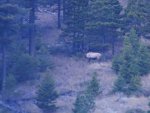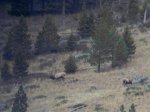I carry a canon elph and love it but its always alittle disappointing watching the sun rise glint off a giant bull elk a half mile away and not being able to capture it with a point and shoot. I'm considering getting a canon rebel but having a hard time sorting thru the various lens configurations since its not as easy as 10x, 16x etc... From my research I think a decent 300mm lens on the rebel t4i would capture distant wildlife pretty well (I.e. elk on distant mountainside easily viewed with 10x42 binos.) Can anyone more familiar with this sort of setup offer some advice/opinions?
A rule of thumb: every 50mm of "full-frame (35mm sensor) equivalent focal length" is equal to 1x of magnification. Since the Rebel t4i is a "crop sensor" camera you multiply the lens focal length by 1.6. So, your 300mm lens is a 480mm lens in full frame equivalency.
Then you take this number 480 and divide by 50 to get your magnification. So 480/50 is 9.6x.
Super-zoom bridge cameras give a lot more magnification with still very good image quality. However, a "60x zoom" camera does NOT PROVIDE 60x magnification. Instead the 60x refers to how much longer the focal length is at max zoom than min zoom. So a 60x camera might have a full frame equivalency focal length range of 20-1200mm, where 1200 is 60 times 20, but in magnification terms that 1200mm long end is really 1200/50 = 24x magnfication.
If you really want to get close, you need a quality spotting scope and digiscoping setup, which can provide super long effective focal lengths in the 3500mm+ range.



